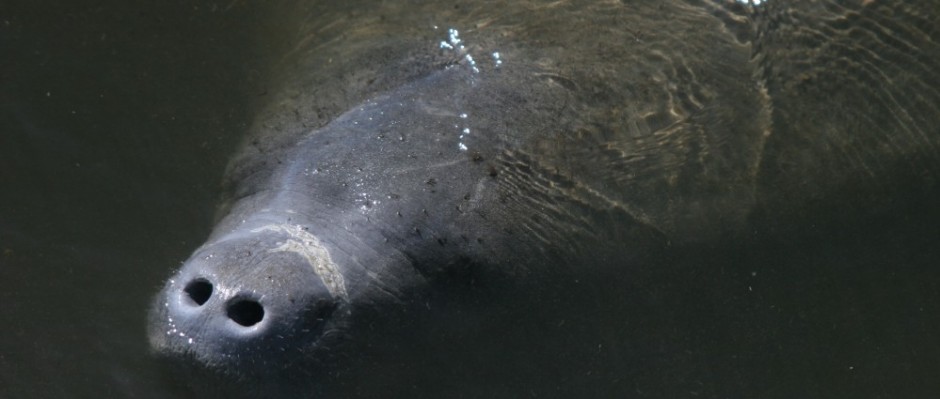Manatees in captivity are fed a diet consisting predominately of romaine lettuce, which doesn’t vary dramatically in composition over the course of the year. 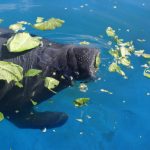
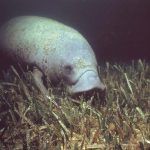
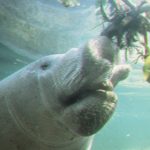 In the wild, manatees consume numerous freshwater plants and sea grasses, with Southern naiad, hydrilla, and paragrass being the preferred species of freshwater plants. Turtle grass, manatee grass, shoal grass and clover grass likely constitute the primary food sources in saltwater systems. To a lesser extent manatees may also eat invertebrates, terrestrial grasses growing close enough to the shore to reach, acorns which have fallen into the water, and the flesh of fish caught in gill nets.
In the wild, manatees consume numerous freshwater plants and sea grasses, with Southern naiad, hydrilla, and paragrass being the preferred species of freshwater plants. Turtle grass, manatee grass, shoal grass and clover grass likely constitute the primary food sources in saltwater systems. To a lesser extent manatees may also eat invertebrates, terrestrial grasses growing close enough to the shore to reach, acorns which have fallen into the water, and the flesh of fish caught in gill nets.
The amount of nutrients derived from eating plants varies according to which part of the plant is consumed, and also varies depending upon the age of the different parts. Absorption efficiency of nutrients is affected by digestive tract morphology, food type and quality, seasonality, meal size, time between meals, and the nutritional state of the animal. Manatees occasionally consume only the leaves of plants and at other times dig up rhizomes and consume the entire plant. When a manatee concentrates its feeding in one area for an extended time, it may eat tunnels through the mass of vegetation.
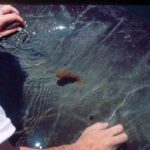 Little is known about how much energy manatees assimilate from the various types of wild forage they consume. Naturally occurring, apparently inassimilable minerals have been used before as dietary markers in various lizards, birds, and mammals. In all of these studies, manganese was determined to be a good marker for use in dietary studies as virtually none of it is absorbed across the gut. Another advantage of using manganese is that it is potentially useful in determining the assimilation efficiency of free-ranging animals. This technique basically involves collecting food and fecal samples and comparing the concentration of manganese in each.
Little is known about how much energy manatees assimilate from the various types of wild forage they consume. Naturally occurring, apparently inassimilable minerals have been used before as dietary markers in various lizards, birds, and mammals. In all of these studies, manganese was determined to be a good marker for use in dietary studies as virtually none of it is absorbed across the gut. Another advantage of using manganese is that it is potentially useful in determining the assimilation efficiency of free-ranging animals. This technique basically involves collecting food and fecal samples and comparing the concentration of manganese in each.
The use of naturally occurring manganese as an inert marker allows us to measure the assimilation efficiencies of manatees in captivity and, theoretically, in the wild and to assess the impacts of varying environmental conditions on their nutritional status. The goal of the present project was to determine the assimilation efficiency, and thereby how much energy is gained, for manatees consuming a seagrass diet.
It has long been assumed that the nutritional ecology of megaherbivores is largely a function of their extreme body size and it has always been thought that larger animals can tolerate diets of lesser quality because of the higher digestive efficiency that results from long retention times (due to a longer intestine) and lower relative energy requirements. There is limited information available for most megaherbivores, but apparently elephants do not make use of the high digestive potential that is theoretically provided by their massive body size. They tend to have faster passage times and lower digestive efficiencies than might be predicted based solely on body size. At least some of these attributes are likely due to the surprisingly short (for their body size) digestive tract. Measured efficiencies range from 22%, for African elephants on a zoo diet to 73% for Asian elephants eating palm leaves. Most studies indicate efficiencies on hay diets ranging from 33-53% . Data for wild male elephants, feeding predominantly on browse in Kruger National Park, indicated efficiencies of 29.7% – 44.7%.
Assimilation efficiency (AE%) of both captive and free-ranging West Indian manatees (Trichechus manatus latirostris) was assessed using non-assimilated indirect markers, manganese and lignin. AE%, measured using manganese, did not differ significantly from AE% assessed using lignin confirming the efficacy of the manganese approach. Manatees have AE% comparable to elephants and horses but have a proportionally larger gastrointestinal tract and a significantly longer transit time (7 days). GI tract samples, obtained from recently dead animals, showed that manganese concentrations were lowest in the stomach, remained low in the duodenum and small intestine, but increased in the cecum, colon and rectum consistent with colonic digestion. Wild manatees consuming marine vegetation had significantly 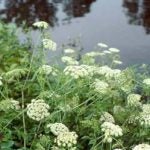
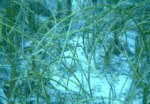 lower AE% [46.9 ± 5.0% (n=8)] than those consuming freshwater vegetation [77.8 ± 6.9% (n=7)] which in turn were significantly lower than captive manatees consuming lettuce [84.0 ± 4.4%, n=37]. Wild manatees eating seagrasses had significantly higher AE% than long-term captive animals consuming seagrass for short periods of time (46.5 ± 4.4% versus 41.1 ± 2.6%, respectively). The ramification of low assimilation efficiency is that manatees consuming seagrasses require a greater standing biomass to support their needs than would be required if they were eating freshwater vegetation. Given the large quantities of seagrass required to sustain manatees, especially during cold weather, it is critical to implement habitat conservation and protection before considering down-listing or de-listing manatees as an endangered species.
lower AE% [46.9 ± 5.0% (n=8)] than those consuming freshwater vegetation [77.8 ± 6.9% (n=7)] which in turn were significantly lower than captive manatees consuming lettuce [84.0 ± 4.4%, n=37]. Wild manatees eating seagrasses had significantly higher AE% than long-term captive animals consuming seagrass for short periods of time (46.5 ± 4.4% versus 41.1 ± 2.6%, respectively). The ramification of low assimilation efficiency is that manatees consuming seagrasses require a greater standing biomass to support their needs than would be required if they were eating freshwater vegetation. Given the large quantities of seagrass required to sustain manatees, especially during cold weather, it is critical to implement habitat conservation and protection before considering down-listing or de-listing manatees as an endangered species.
